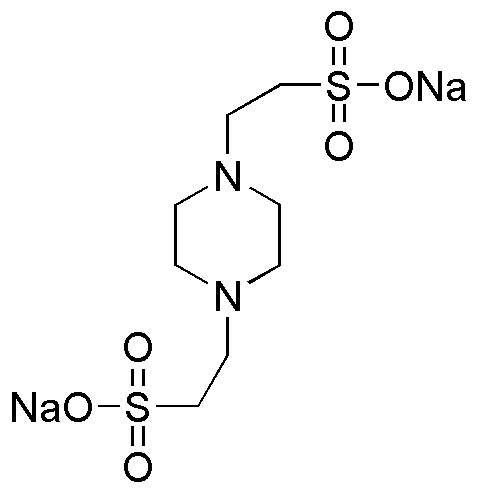PIPES disodium salt is widely utilized in research focused on:
- Biological Buffers: It serves as an effective buffering agent in biological and biochemical research, maintaining pH stability in cell culture and protein studies.
- Pharmaceutical Formulations: Used in drug development, it helps stabilize active ingredients, enhancing the efficacy and shelf-life of medications.
- Electrophoresis: In laboratories, it is commonly employed in gel electrophoresis for separating biomolecules, providing clear and reproducible results.
- Environmental Testing: Its application in environmental science includes assessing the impact of pollutants on aquatic life, facilitating accurate monitoring of water quality.
- Research on Protein Interactions: PIPES disodium salt is beneficial in studies investigating protein-ligand interactions, aiding in the understanding of biological processes.
General Information
Properties
Safety and Regulations
Applications
PIPES disodium salt is widely utilized in research focused on:
- Biological Buffers: It serves as an effective buffering agent in biological and biochemical research, maintaining pH stability in cell culture and protein studies.
- Pharmaceutical Formulations: Used in drug development, it helps stabilize active ingredients, enhancing the efficacy and shelf-life of medications.
- Electrophoresis: In laboratories, it is commonly employed in gel electrophoresis for separating biomolecules, providing clear and reproducible results.
- Environmental Testing: Its application in environmental science includes assessing the impact of pollutants on aquatic life, facilitating accurate monitoring of water quality.
- Research on Protein Interactions: PIPES disodium salt is beneficial in studies investigating protein-ligand interactions, aiding in the understanding of biological processes.
Documents
Safety Data Sheets (SDS)
The SDS provides comprehensive safety information on handling, storage, and disposal of the product.
Product Specification (PS)
The PS provides a comprehensive breakdown of the product’s properties, including chemical composition, physical state, purity, and storage requirements. It also details acceptable quality ranges and the product's intended applications.
Certificates of Analysis (COA)
Search for Certificates of Analysis (COA) by entering the products Lot Number. Lot and Batch Numbers can be found on a product’s label following the words ‘Lot’ or ‘Batch’.
*Catalog Number
*Lot Number
Certificates Of Origin (COO)
This COO confirms the country where the product was manufactured, and also details the materials and components used in it and whether it is derived from natural, synthetic, or other specific sources. This certificate may be required for customs, trade, and regulatory compliance.
*Catalog Number
*Lot Number
Safety Data Sheets (SDS)
The SDS provides comprehensive safety information on handling, storage, and disposal of the product.
DownloadProduct Specification (PS)
The PS provides a comprehensive breakdown of the product’s properties, including chemical composition, physical state, purity, and storage requirements. It also details acceptable quality ranges and the product's intended applications.
DownloadCertificates of Analysis (COA)
Search for Certificates of Analysis (COA) by entering the products Lot Number. Lot and Batch Numbers can be found on a product’s label following the words ‘Lot’ or ‘Batch’.
*Catalog Number
*Lot Number
Certificates Of Origin (COO)
This COO confirms the country where the product was manufactured, and also details the materials and components used in it and whether it is derived from natural, synthetic, or other specific sources. This certificate may be required for customs, trade, and regulatory compliance.


